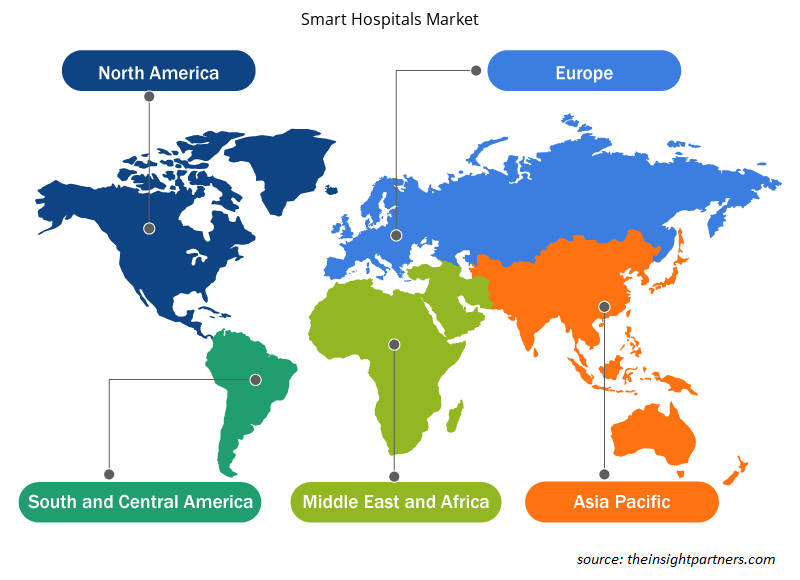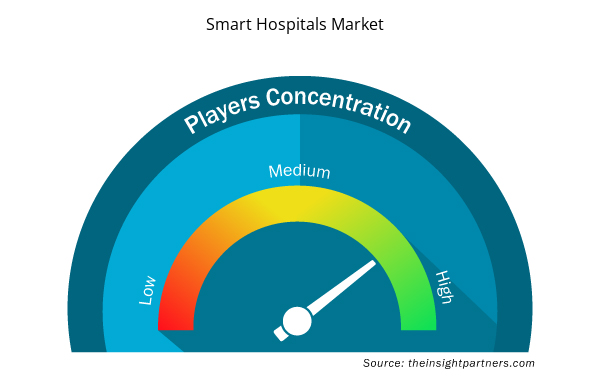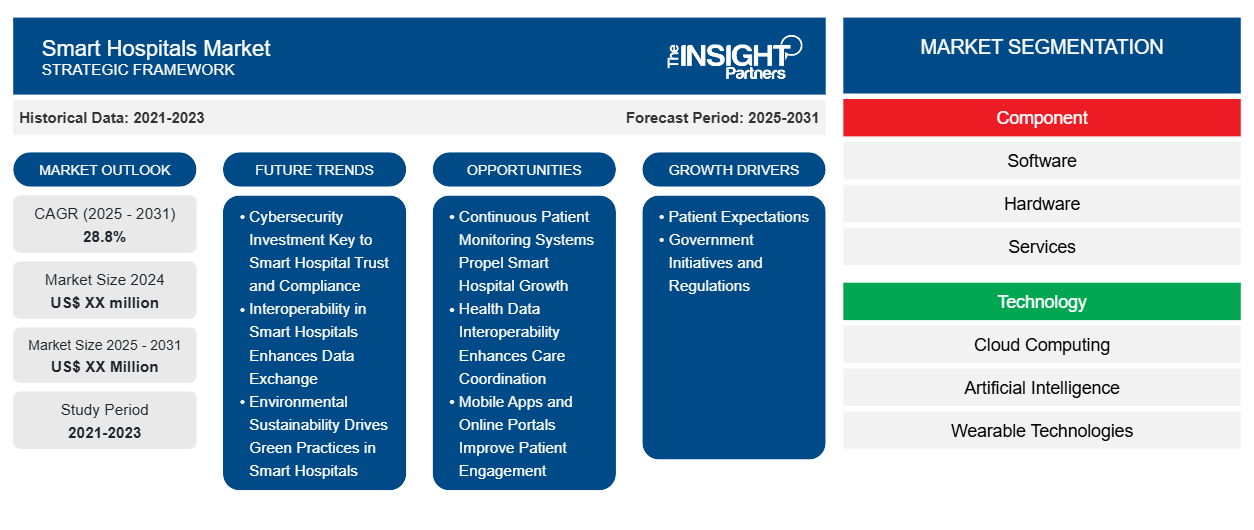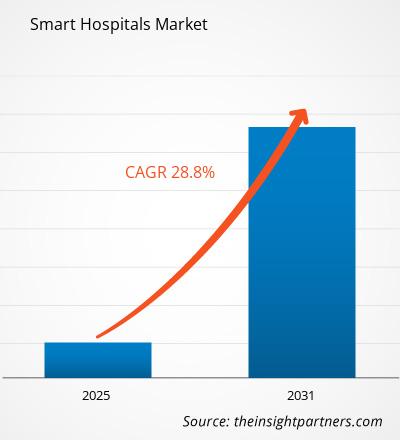Es wird erwartet, dass der Markt für intelligente Krankenhäuser von 2024 bis 2031 eine durchschnittliche jährliche Wachstumsrate (CAGR) von 28,8 % verzeichnet, wobei die Marktgröße von XX Millionen US-Dollar im Jahr 2024 auf XX Millionen US-Dollar im Jahr 2031 anwachsen wird.
Der Marktbericht für intelligente Krankenhäuser umfasst die Analyse nach Komponente, Technologie, Anwendung, Konnektivität und Geografie.
Zweck des Berichts
Der Bericht „Smart Hospitals Market“ von The Insight Partners soll die aktuelle Situation und das zukünftige Wachstum sowie die wichtigsten treibenden Faktoren, Herausforderungen und Chancen beschreiben. Dies wird verschiedenen Geschäftspartnern Einblicke geben, wie zum Beispiel:
- Technologieanbieter/-hersteller: Um die sich entwickelnde Marktdynamik zu verstehen und die potenziellen Wachstumschancen zu kennen, damit sie fundierte strategische Entscheidungen treffen können.
- Investoren: Durchführung einer umfassenden Trendanalyse hinsichtlich der Marktwachstumsrate, der finanziellen Marktprognosen und der Chancen entlang der Wertschöpfungskette.
- Regulierungsbehörden: Zur Regulierung von Richtlinien und Überwachungsaktivitäten auf dem Markt mit dem Ziel, Missbrauch zu minimieren, das Vertrauen der Anleger zu bewahren und die Integrität und Stabilität des Marktes aufrechtzuerhalten.
Marktsegmentierung für intelligente Krankenhäuser
Komponente
- Software
- Hardware
- Dienstleistungen
Technologie
- Cloud Computing
- Künstliche Intelligenz
- Tragbare Technologien
- Identifizierung von Funkfrequenzen
- Sonstiges
Anwendung
- Fernverwaltung von Medikamenten
- Vernetzte medizinische Bildgebung
- Medizinische Hilfe
- Elektronische Gesundheitsakte und klinischer Arbeitsablauf
- Ambulante Vigilanz
Konnektivität
- Verdrahtet
- Kabellos
Passen Sie diesen Bericht Ihren Anforderungen an
Sie erhalten kostenlos individuelle Anpassungen an jedem Bericht, einschließlich Teilen dieses Berichts oder einer Analyse auf Länderebene, eines Excel-Datenpakets sowie tolle Angebote und Rabatte für Start-ups und Universitäten.
- Holen Sie sich die wichtigsten Markttrends aus diesem Bericht.Dieses KOSTENLOSE Beispiel umfasst eine Datenanalyse von Markttrends bis hin zu Schätzungen und Prognosen.
Wachstumstreiber auf dem Markt für intelligente Krankenhäuser
- Patientenerwartungen: Die zunehmend hohen Erwartungen der Patienten an Qualität und personalisierte Pflege erfordern intelligente Krankenhäuser, die den neuen Anforderungen gerecht werden. Dieser Wandel trägt zu einem massiven Marktwachstum bei, da der internationale Markt einen Anstieg der Investitionen zur Förderung der Patienteneinbindung aufweist. Marktanalysen zufolge werden Krankenhäuser, die diese intelligenten Technologien einführen, einen größeren Marktanteil einnehmen und so die Innovation bei der Leistungserbringung und im Gesundheitswesen im Allgemeinen verbessern.
- Regierungsinitiativen und -vorschriften: Regierungsinitiativen und -vorschriften, die Innovationen im Gesundheitswesen fördern, sind von grundlegender Bedeutung, um den Markt für intelligente Krankenhäuser voranzutreiben. Richtlinien, die die Effizienz des Gesundheitswesens steigern und die Behandlungsergebnisse für Patienten verbessern, werden wahrscheinlich Investoren in intelligente Technologien ermutigen. Aus diesem Grund wird der Marktüberblick für das Marktsegment optimistischer sein, mit einer Wachstumsperspektive, die durch positive Vorschriften gestützt wird. Wachstumstrends sind zu erwarten, da die globale Branche mit zusätzlichen Marktanteilen durch Unternehmen reagiert, die in digitale Gesundheitslösungen investieren, wie sich in jüngsten Marktberichten und Branchentrendanalysen widerspiegelt.
Zukünftige Trends auf dem Markt für intelligente Krankenhäuser
- Investitionen in die Cybersicherheit sind der Schlüssel zu Vertrauen und Compliance in Smart Hospitals: Mit der zunehmenden Digitalisierung in Smart Hospitals ist die Cybersicherheit in den Fokus geraten. Der Schutz sensibler Patientendaten war schon immer sehr wichtig, daher investieren Gesundheitsdienstleister mehr in robuste Cybersicherheitsmaßnahmen. Dies schafft Spielraum für Unternehmen, die Lösungen im Bereich Cybersicherheit anbieten und mit Gesundheitsdienstleistern zusammenarbeiten können. Da sich die Marktstrategie in Richtung ganzheitlicher Sicherheitsprotokolle verlagert, ist dies sehr wichtig, um das Vertrauen der Patienten und ihre Compliance aufrechtzuerhalten. Dieser Trend bildet das Rückgrat eines widerstandsfähigen Smart-Hospital-Systems gegen Cyberbedrohungen.
- Interoperabilität in intelligenten Krankenhäusern verbessert den Datenaustausch: Die Interoperabilität in intelligenten Krankenhäusern gewinnt an Bedeutung, da Gesundheitssysteme weiterhin nach einem schmerzfreien Datenaustausch streben. Der neue Trend fördert die Interoperabilität und verbessert die Patientenergebnisse zwischen Gesundheitsdienstleistern. Laut PEST-Analyse hat der regulatorische Druck auf standardisierte Datenformate Innovationen vorangetrieben. Wichtige Akteure haben an Marktstrategien gearbeitet, indem sie interoperable Lösungen entwickelt haben, die einen verbesserten Datenaustausch ermöglichen und so die Marktdynamik positiv beeinflussen und eine angemessene Patientenversorgung gewährleisten.
- Umweltverträglichkeit fördert umweltfreundliche Praktiken in Smart Hospitals: Das Bewusstsein für Umweltverträglichkeit zwingt Smart Hospitals, umweltfreundliche Praktiken einzuführen. Dazu gehören energieeffiziente Infrastruktur und Abfallreduzierungsprogramme, die nach und nach zu einem integralen Bestandteil des Krankenhausbetriebs werden. Eine PEST-Analyse lenkt die Aufmerksamkeit auf den rechtlichen Rahmen für die Umsetzung von Nachhaltigkeit im Gesundheitswesen. Die allgemeinen Markttrends werden von den führenden Akteuren tatsächlich positiv beeinflusst, basierend auf den Marktstrategien, die sich auf umweltfreundliche Technologien und nachhaltige Praktiken konzentrieren. In dieser Hinsicht verbessern Smart Hospitals nicht nur ihre Leistung als Betriebseinheiten, sondern stärken auch ihr öffentliches Image und die Patientenzufriedenheit.
Marktchancen für intelligente Krankenhäuser
- Systeme zur kontinuierlichen Patientenüberwachung treiben das Wachstum intelligenter Krankenhäuser voran: Das System zur kontinuierlichen Patientenüberwachung stellt einen wichtigen Wachstumsbereich für intelligente Krankenhäuser dar. Aus diesem Grund zeigt eine Wettbewerbsanalyse, dass die in Nordamerika ansässigen Krankenhäuser, die in diese Technologien investieren, in einer guten Position sind, um in der Branche einzigartig zu wirken, da sie den steigenden Erwartungen in Bezug auf ein proaktives Gesundheitsmanagement gerecht werden.
- Interoperabilität von Gesundheitsdaten verbessert die Koordination der Versorgung: Die Notwendigkeit der Interoperabilität von Gesundheitsdaten eröffnet intelligente Krankenhäusern in Wachstumsbereichen große Chancen. Interoperable Systeme stellen sicher, dass Informationen nahtlos zwischen den Anbietern ausgetauscht werden, was wiederum die Koordination und die Ergebnisse der Versorgung verbessert. Diese Initiative ist insbesondere in Nordamerika erforderlich, da die dortigen Gesundheitssysteme die Patienten fragmentieren und bei ihrer Behandlung Probleme verursachen.
- Mobile Apps und Online-Portale verbessern die Patienteneinbindung: Mit mobilen Anwendungen und Online-Portalen können Patienten ihre Gesundheitsversorgung besser steuern. Dies ist auch im nordamerikanischen Sektor von entscheidender Bedeutung, da sich die Präferenzen der Patienten kontinuierlich von einer weniger interaktiven, erfahrungsbasierten Gesundheitsversorgung hin zu einer interaktiveren Erfahrung verschieben. Eine detaillierte Wettbewerbsanalyse zeigt, dass sich „patienteneinbindungsorientierte“ Krankenhäuser im Gesundheitssektor hervortun können, was sich in Bezug auf die Patientenzufriedenheit als relativ beeindruckender erweist und somit eine langfristige Loyalität der Patienten aufbaut.
Regionale Einblicke in den Markt für intelligente Krankenhäuser
Die regionalen Trends und Faktoren, die den Smart Hospitals-Markt im Prognosezeitraum beeinflussen, wurden von den Analysten von Insight Partners ausführlich erläutert. In diesem Abschnitt werden auch die Marktsegmente und die Geografie des Smart Hospitals-Marktes in Nordamerika, Europa, im asiatisch-pazifischen Raum, im Nahen Osten und Afrika sowie in Süd- und Mittelamerika erörtert.

- Holen Sie sich die regionalen Daten für den Smart Hospitals-Markt
Umfang des Marktberichts zu intelligenten Krankenhäusern
| Berichtsattribut | Details |
|---|---|
| Marktgröße im Jahr 2024 | XX Millionen US-Dollar |
| Marktgröße bis 2031 | XX Millionen US-Dollar |
| Globale CAGR (2025 - 2031) | 28,8 % |
| Historische Daten | 2021-2023 |
| Prognosezeitraum | 2025–2031 |
| Abgedeckte Segmente | Nach Komponente
|
| Abgedeckte Regionen und Länder | Nordamerika
|
| Marktführer und wichtige Unternehmensprofile |
|
Marktteilnehmerdichte für Smart Hospitals: Auswirkungen auf die Geschäftsdynamik verstehen
Der Markt für intelligente Krankenhäuser wächst rasant. Dies wird durch die steigende Nachfrage der Endnutzer aufgrund von Faktoren wie sich entwickelnden Verbraucherpräferenzen, technologischen Fortschritten und einem größeren Bewusstsein für die Vorteile des Produkts vorangetrieben. Mit der steigenden Nachfrage erweitern Unternehmen ihr Angebot, entwickeln Innovationen, um die Bedürfnisse der Verbraucher zu erfüllen, und nutzen neue Trends, was das Marktwachstum weiter ankurbelt.
Die Marktteilnehmerdichte bezieht sich auf die Verteilung der Firmen oder Unternehmen, die in einem bestimmten Markt oder einer bestimmten Branche tätig sind. Sie gibt an, wie viele Wettbewerber (Marktteilnehmer) in einem bestimmten Marktraum im Verhältnis zu seiner Größe oder seinem gesamten Marktwert präsent sind.
Die wichtigsten auf dem Markt für intelligente Krankenhäuser tätigen Unternehmen sind:
- Stanley-Gesundheitswesen
- Qualcomm Technologies, Inc.
- Koninklijke Philips NV
- Allscripts Healthcare, LLC
- McKesson Corporation
Haftungsausschluss : Die oben aufgeführten Unternehmen sind nicht in einer bestimmten Reihenfolge aufgeführt.

- Überblick über die wichtigsten Akteure auf dem Smart Hospitals-Markt
Wichtige Verkaufsargumente
- Umfassende Abdeckung: Der Bericht deckt die Analyse der Produkte, Dienste, Typen und Endbenutzer des Marktes für intelligente Krankenhäuser umfassend ab und bietet einen ganzheitlichen Überblick.
- Expertenanalyse: Der Bericht basiert auf dem umfassenden Verständnis von Branchenexperten und Analysten.
- Aktuelle Informationen: Der Bericht stellt durch die Abdeckung aktueller Informationen und Datentrends Geschäftsrelevanz sicher.
- Anpassungsoptionen: Dieser Bericht kann angepasst werden, um spezifische Kundenanforderungen zu erfüllen und die Geschäftsstrategien optimal anzupassen.
Der Forschungsbericht zum Smart Hospitals-Markt kann daher dabei helfen, die Branchensituation und Wachstumsaussichten zu entschlüsseln und zu verstehen. Obwohl es einige berechtigte Bedenken geben kann, überwiegen die allgemeinen Vorteile dieses Berichts tendenziell die Nachteile.
- Historische Analyse (2 Jahre), Basisjahr, Prognose (7 Jahre) mit CAGR
- PEST- und SWOT-Analyse
- Marktgröße Wert/Volumen – Global, Regional, Land
- Branche und Wettbewerbsumfeld
- Excel-Datensatz



Report Coverage
Revenue forecast, Company Analysis, Industry landscape, Growth factors, and Trends

Segment Covered
This text is related
to segments covered.

Regional Scope
North America, Europe, Asia Pacific, Middle East & Africa, South & Central America

Country Scope
This text is related
to country scope.
Häufig gestellte Fragen
Some of the customization options available based on request are additional 3-5 company profiles and country-specific analysis of 3-5 countries of your choice. Customizations are to be requested/discussed before making final order confirmation, as our team would review the same and check the feasibility.
The report can be delivered in PDF/PPT format; we can also share excel dataset based on the request.
Key companies in this market are: Stanley Healthcare, Qualcomm Technologies Inc, Koninklijke Philips N V, Allscripts Healthcare LLC, McKesson Corporation, Cerner Corporation, Honeywell International Inc, GE Healthcare, SAP SE
The Smart Hospitals Market is expected to register a CAGR of 28.8% from 2023-2031.
Key future trends in this market are - Integration of IoT technologies, Growth in patient-centered care, Adoption of AI-driven solutions
The major factors impacting the Smart Hospitals Market are: Regulatory Support, Increasing Patient Demand, and Technological Advancements
Trends and growth analysis reports related to Technology, Media and Telecommunications : READ MORE..
1. Stanley Healthcare
2. Qualcomm Technologies, Inc.
3. Koninklijke Philips N.V.
4. Allscripts Healthcare, LLC
5. McKesson Corporation
6. Cerner Corporation
7. Honeywell International Inc.
8. GE Healthcare
9. SAP SE
10. Cognizant
11. Medtronic
12. Honeywell Life Care Solutions
13. Microsoft
14. Diabetizer
15. Proteus Digital Health
16. AdhereTECH
17. PhysIQ
18. IQVIA
19. Wipro Limited
20. SCIOInspire, Corp
The Insight Partners performs research in 4 major stages: Data Collection & Secondary Research, Primary Research, Data Analysis and Data Triangulation & Final Review.
- Data Collection and Secondary Research:
As a market research and consulting firm operating from a decade, we have published and advised several client across the globe. First step for any study will start with an assessment of currently available data and insights from existing reports. Further, historical and current market information is collected from Investor Presentations, Annual Reports, SEC Filings, etc., and other information related to company’s performance and market positioning are gathered from Paid Databases (Factiva, Hoovers, and Reuters) and various other publications available in public domain.
Several associations trade associates, technical forums, institutes, societies and organization are accessed to gain technical as well as market related insights through their publications such as research papers, blogs and press releases related to the studies are referred to get cues about the market. Further, white papers, journals, magazines, and other news articles published in last 3 years are scrutinized and analyzed to understand the current market trends.
- Primary Research:
The primarily interview analysis comprise of data obtained from industry participants interview and answers to survey questions gathered by in-house primary team.
For primary research, interviews are conducted with industry experts/CEOs/Marketing Managers/VPs/Subject Matter Experts from both demand and supply side to get a 360-degree view of the market. The primary team conducts several interviews based on the complexity of the markets to understand the various market trends and dynamics which makes research more credible and precise.
A typical research interview fulfils the following functions:
- Provides first-hand information on the market size, market trends, growth trends, competitive landscape, and outlook
- Validates and strengthens in-house secondary research findings
- Develops the analysis team’s expertise and market understanding
Primary research involves email interactions and telephone interviews for each market, category, segment, and sub-segment across geographies. The participants who typically take part in such a process include, but are not limited to:
- Industry participants: VPs, business development managers, market intelligence managers and national sales managers
- Outside experts: Valuation experts, research analysts and key opinion leaders specializing in the electronics and semiconductor industry.
Below is the breakup of our primary respondents by company, designation, and region:

Once we receive the confirmation from primary research sources or primary respondents, we finalize the base year market estimation and forecast the data as per the macroeconomic and microeconomic factors assessed during data collection.
- Data Analysis:
Once data is validated through both secondary as well as primary respondents, we finalize the market estimations by hypothesis formulation and factor analysis at regional and country level.
- Macro-Economic Factor Analysis:
We analyse macroeconomic indicators such the gross domestic product (GDP), increase in the demand for goods and services across industries, technological advancement, regional economic growth, governmental policies, the influence of COVID-19, PEST analysis, and other aspects. This analysis aids in setting benchmarks for various nations/regions and approximating market splits. Additionally, the general trend of the aforementioned components aid in determining the market's development possibilities.
- Country Level Data:
Various factors that are especially aligned to the country are taken into account to determine the market size for a certain area and country, including the presence of vendors, such as headquarters and offices, the country's GDP, demand patterns, and industry growth. To comprehend the market dynamics for the nation, a number of growth variables, inhibitors, application areas, and current market trends are researched. The aforementioned elements aid in determining the country's overall market's growth potential.
- Company Profile:
The “Table of Contents” is formulated by listing and analyzing more than 25 - 30 companies operating in the market ecosystem across geographies. However, we profile only 10 companies as a standard practice in our syndicate reports. These 10 companies comprise leading, emerging, and regional players. Nonetheless, our analysis is not restricted to the 10 listed companies, we also analyze other companies present in the market to develop a holistic view and understand the prevailing trends. The “Company Profiles” section in the report covers key facts, business description, products & services, financial information, SWOT analysis, and key developments. The financial information presented is extracted from the annual reports and official documents of the publicly listed companies. Upon collecting the information for the sections of respective companies, we verify them via various primary sources and then compile the data in respective company profiles. The company level information helps us in deriving the base number as well as in forecasting the market size.
- Developing Base Number:
Aggregation of sales statistics (2020-2022) and macro-economic factor, and other secondary and primary research insights are utilized to arrive at base number and related market shares for 2022. The data gaps are identified in this step and relevant market data is analyzed, collected from paid primary interviews or databases. On finalizing the base year market size, forecasts are developed on the basis of macro-economic, industry and market growth factors and company level analysis.
- Data Triangulation and Final Review:
The market findings and base year market size calculations are validated from supply as well as demand side. Demand side validations are based on macro-economic factor analysis and benchmarks for respective regions and countries. In case of supply side validations, revenues of major companies are estimated (in case not available) based on industry benchmark, approximate number of employees, product portfolio, and primary interviews revenues are gathered. Further revenue from target product/service segment is assessed to avoid overshooting of market statistics. In case of heavy deviations between supply and demand side values, all thes steps are repeated to achieve synchronization.
We follow an iterative model, wherein we share our research findings with Subject Matter Experts (SME’s) and Key Opinion Leaders (KOLs) until consensus view of the market is not formulated – this model negates any drastic deviation in the opinions of experts. Only validated and universally acceptable research findings are quoted in our reports.
We have important check points that we use to validate our research findings – which we call – data triangulation, where we validate the information, we generate from secondary sources with primary interviews and then we re-validate with our internal data bases and Subject matter experts. This comprehensive model enables us to deliver high quality, reliable data in shortest possible time.


 Holen Sie sich ein kostenloses Muster für diesen Bericht
Holen Sie sich ein kostenloses Muster für diesen Bericht